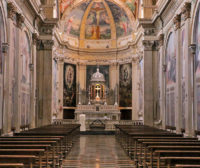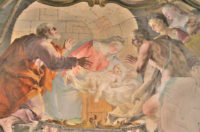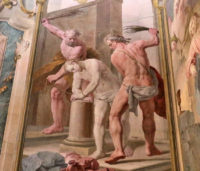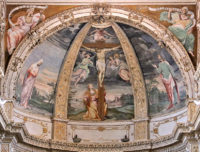Certosa of Garegnano was founded in 1359 by Giovanni Visconti Archbishop of Milan and his brother Luchino in the village of Garegnano, which had already become part of the city of Milan.
Coining into Milan from the motorway to the lakes, you can see monumental assemble of the charterhouse from the apsis side with its late sixteenth century refacings, with brick decorations belonging to the previous building.
Certosa of Garegnano offers a harmonious view of proportioned equilibrium. It can be reached from Viale Certosa by turning into Via Garegnano and reaching Via Pareto which, from Piazzale del Cimitero Maggiore, leads to the entrance, where a doorway opens onto a vestibule beyond which opens the poligona! courtyard, with the church as a background. The simple-lined, well balanced facade is the work of the able hands of Galeazzo Alessi, called in to reface it between 1560 and 1570.
It also seems that Seregni, Alessi’s contcmporarv, is not to be completely excluded from its execution as their wrork is verv similar and one is often mistaken for the other. Besides the architectonic assembly, the main attractions are the frescoes which Daniele Crespi painted between 1628 and 1629, these illustrate the life of St. Brunone, founder of the order of Carthusian monks.
The most expressive painting is the one which illustrates the funeral of the Parisian doctor Raimondo Diocres, and it is said that Lord Byron stood in ecstasy in front of it for hours on end. Other than Crespi’s celebrated frescoes there are painting bv Petcrzano, Bellotti, Genovesino and Salmeggia. Francesco Petrach stopped in the Linterno Villa in 1357, he went there to inhale the perfume of the “closed garden of Garegnano” where one of his brothers. Gerardo, was a monk. Many famous neonle have stayed at the charterhouse, among them St. Carlo Borromeo and his cousin Federico; Philip IV, king of Spain, and his brother the Archbishop of Toledo.
































